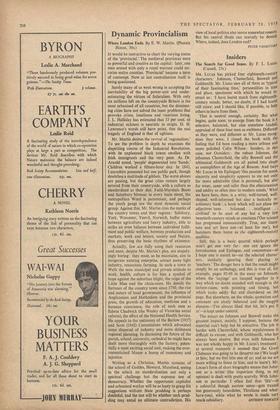Dynamic Provincialism
IT would be instructive to chart the varying status of the 'provincial.' The medieval provinces were as powerful and creative as the capital : later, one man armed with only a royal warrant could ter- rorise entire counties. 'Provincial' became a term of contempt. Now at last centralisation itself is being questioned.
Surely many of us went wrong in accepting the inevitability of the big power-unit and under- estimating the virtues of federalism. With only six millions left on the countryside Britain is the most urbanised of all countries, but the dominat- ing cities have not solved the inner problems that provoke crime, loneliness and vicarious living. J. L. Halliday has estimated that 33 per cent. of industrial sickness is neurotic in origin. D. H. Lawrence's words still have point, that the real tragedy of England is that of ugliness.
Mr. Martin desires the revival of 'regionalism.' To see the problem in depth he examines the dispiriting course of the Industrial Revolution, with its unplanned black towns swollen with Irish immigrants and the very poor. As Dr. Arnold noted, 'people' degenerated into 'hands.' Children worked a fifteen-hour day. In 1842, Lancashire possessed but one public park, though doubtless a multitude of gibbets. The worst abuses are passing, but the great cities remain largely severed from their countryside, with a culture as standardised as their diet. Field-Marshals Boots and Sainsbury bivouac in every main street, the metropolitan Word is paramount, and perhaps the youth gangs are the most dynamic social group. Against this, Mr. Martin cites the merits of the country towns and their regions : Salisbury, York, Worcester, Yeovil, Norwich, buffer states between agriculture and heavy industry, able to strike an even balance between individual fulfil- ment and public welfare, between production and markets, work and leisure, society and Nature, thus preserving the basic rhythms of existence.
Actually, few are fully using their resources and most, despite Mr. Martin's plea, are stupefy- ingly boring : they must, as he maintains, aim to invigorate existing enterprise, attract more light industry, resuscitate farming. In such a town as Wells the sane municipal and private attitude to work, health, culture is for him a symbol of hope against the suburban blight, the reign of the Little Man and the chain-store. He details the fortunes of the country town since 1750, the rise and nature of local government, the influence of Anglicanism and Methodism and the provincial press, the growth of education, medicine and a humane conscience, the role of such men as Edwin Chadwick (the Wesley of Victorian social reform), the effect of the National Health Service. He appeals to the testimony of the Barlow (1937) and Scott (1942) Commissions which advocated some dispersal of industry and more deliberate regional planning. In discussing the future of the parish, school, university, cathedral he might have dealt more thoroughly with the factory, poten- tially a most exciting social unit, making the over- romanticised Manor a hump of monotony and injustice.
Writing as a Christian, Martin remains of the school of Geddes, Howard, Mumford, seeing in the attack on standardisation not only a spiritual challenge but the supreme test of democracy. Whether the opportunist capitalist and urbanised worker will be as hasty to grasp his suggestions without State prodding is perhaps doubtful, and the test will be whether such prod- ding may entail an ultimate contradiction. His view of local politics also seems somewhat roseate. But his central thesis can scarcely be denied. Where, indeed, does London end?
PETER VANSITTART


































 Previous page
Previous page